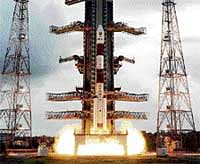Troubles for moon mission erupted in April


However, there was nothing much the space agency could do. The first deviation was reported in April when one of the power regulators connected to the solar panels malfunctioned, cutting power supply to the payload by half. The solar panel jutted out from one side. The 1380-kg cuboid payload is meant for providing 700 MW of power to the craft for maintaining its housekeeping tasks and conducting all experiments with 11 instruments.
“A deviation in the power system was noticed in April. One of the regulators malfunctioned as a result of which the satellite received only 50 per cent power,” a key scientist associated with Chandrayaan-1 mission told Deccan Herald. As a result, all scientific payloads were not switched on all the time.
“We were turning on instruments judiciously as there are housekeeping requirements also,” he said adding it was a management challenge to decide which instrument should be powered at what time. The second shocker came in May when the satellite’s star sensor failed. Its job was to navigate the satellite’s by matching its coordinates with that of the stars.
Once the star sensor failed, on-board gyroscopes were brought into action as a part of the redundancy measures to navigate the probe. But scientists knew perfectly well that it was only a temporary option and it is only a matter of time before Chandrayaan-1 will stop sending signals to the earth.
The gyroscopes were maintaining the craft’s orientation by matching its coordinates against the earth and the moon with constant support from the ground station. It is a complicated process which requires weekly correction. But the extent of course-correction was determined every week depending on the satellite’s position. But navigating through gyroscopes requires one of the antennas to remain perpetually pointed towards the earth. The scientists knew that the earth-facing antenna would not stay in that position for long.
“Deviations and malfunctions can happen in a payload like Chandrayaan-1 which is operating in a hostile environment. There is excessive heat and cosmic radiation and many other adverse factors found in natural space environment,” he said. Loss of Chandrayaan-1 is another instance of a key space mission gone awry. But it is not the first one. Probably the most famous space failure happened three decades ago when the first US space station Skylab prematurely re-entered the earth on July 11, 1979.
The satellite was abandoned in 1974 and left in a parking lot with the expectation that it will stay there for 8 years, after which it was to be elevated to a higher orbit. But increased solar activity enhanced atmospheric drag on the satellite which could no longer stay in the orbit.
It re-entered the earth’s atmosphere prematurely. Though it eventually fell in the Indian Ocean, there was panic in parts of South Asia, including India, as scientists were not absolutely sure where the satellite’ would land. In the last three decades, there were many satellite failures from the USA, Europe, Russia and Japan, including prominent cases like the European Space Agency’s Hipparcos and Japan’s $ 415 million satellite ETS-6.
* Oct 22, 2008: Chandrayaan-1 takes off smoothly from Sriharikota on PSLV C-11 with eleven payloads onboard
* Nov 4, 2008: Chandrayaan-1 enters the lunar orbit after a series of complicated manoeuvers, orchestrated from the Deep Space Network at Byalalu
* Nov 14, 2008: The Moon Impact Probe (MIP), an Indian payload equipped with a video camera, radar altimeter and mass spectrometer, is launched onto the the moon’s surface
* April 26, 2009: The star sensor used for orienting the spacecraft towards the moon, suffers a failure due to radiation rays and is replaced by gyroscopes
* Aug 29, 2009: The Deep Space Network abruptly loses radio contact with Chandrayaan-1, possibly signifying an end to the mission.
Deccan Herald is on WhatsApp Channels| Join now for Breaking News & Editor's Picks